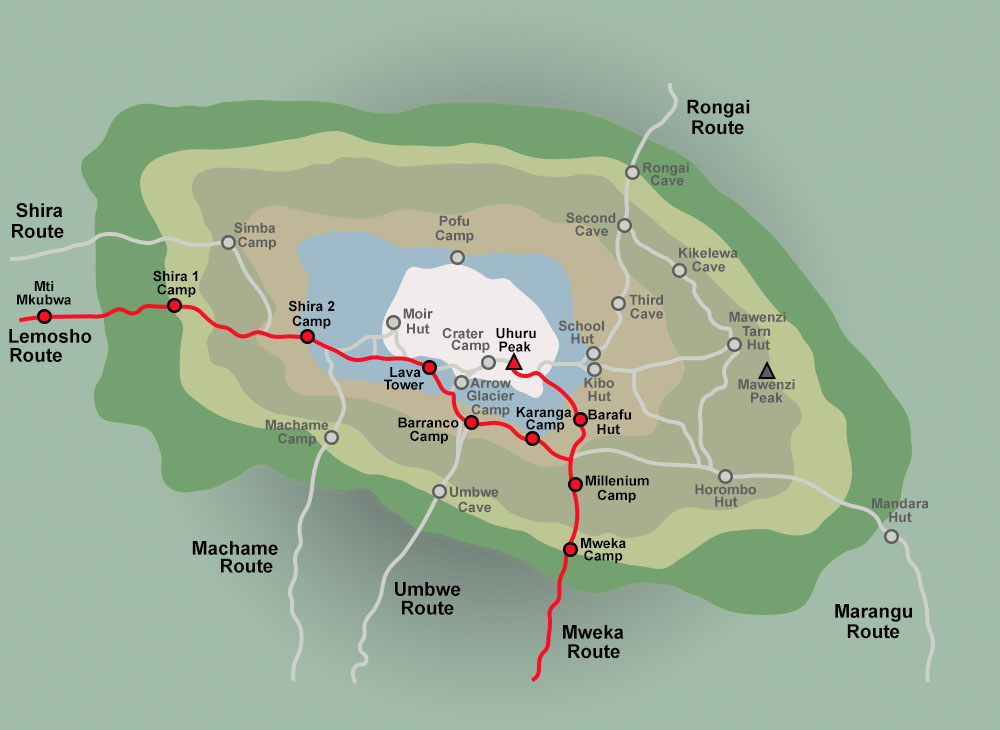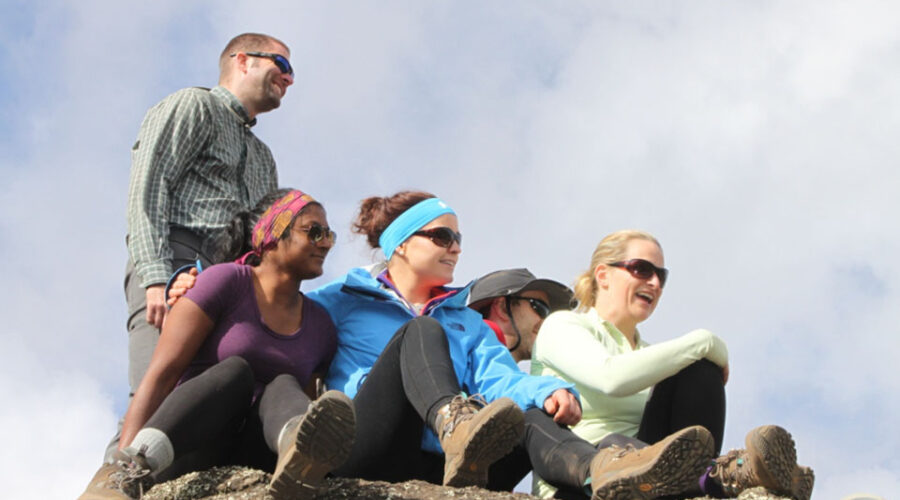The Rongai Route approaches Mount Kilimanjaro from the north, near the Kenyan border, offering a quieter and scenic climb. Starting 45 km from Moshi or 69 km from Arusha, it features diverse landscapes, wildlife, and a high summit success rate. It’s considered one of the easiest routes, suitable for all skill levels. Trekkers sleep in tents, with porters setting up camp daily. The climb typically takes 6 days, with an optional 7-day itinerary for better acclimatization. Descent is via the Marangu Route, providing views from multiple sides of the mountain.
Elevation: 1387/915 m to 1950 m to 2750 m, Distance: 9 km, Hiking Time: 4 hours, Habitat: Montana Forest
You will have an early breakfast. Transfer by our vehicles through many villages and coffee and plantations for a 2–3-hour drive to Rongai gate (1,950 m/6,398 ft). After signing in and preparing the porters, you will start hiking on a wide path winding through fields of maize and potatoes, and then enter into Montana forest. You will then start to climb gently but consistently through an attractive forest that shelters a variety of wildlife. The forest begins to thin as you arrive at Simba Camp (2,600 m/8,530ft) with fantastic views over the Kenyan plains.
Elevation: 2750 m to 3600 m, Distance: 17 km, Hiking Time: 7 hours, Habitat: Moorland
After an early breakfast, you will have a steady ascent to the second camp where you will stop for lunch. You leave the direct trail at this point and strike out across the moorland on a smaller path toward the Mawenzi side peak to Kikelewa Camp in a sheltered valley. At the Kikelewa Camp, you will settle for your dinner and overnight rest.
Elevation: 3600m to 4330m, Distance: 7km, Hiking Time: 4 hours, Habitat: Semi-Desert
After breakfast you will face a short, steep climb up grassy slopes; rewarded by superb all-round views, immersed in the vast surrounding wilderness. Soon after, you leave the vegetation behind and arrive at the Mawenzi Tarn Camp, which is situated in a spectacular cirque directly beneath the towering spires of Mawenzi Peak. After this hike, you will reach the Mawenzi turn hut camp where you will also see the amazing undried Lake with no inlet as well as an outlet here you will have lunch and rest then dinner and overnight at this camp.
This is your extra day on the mountain, and you will spend two nights at Mawenzi Tarn. You will hike up towards Mawenzi for a splendid acclimatization hike. Then after returning to the camp for lunch dinner and overnight.
Elevation: 4330 m to 4695 m, Distance: 8km, Hiking Time: 5 hours, Habitat: Alpine Desert
After an early breakfast, you will cross the lunar desert of the saddle between Kibo peak and Mawenzi Peak to Kibo Huts at the bottom of Kibo’s crater wall. You should spend the remainder of the day resting and preparing for your summit climb.
Elevation: 4695 m to 5895 m to 3690 m, Distance: 4 km up, 14 km down, Hiking Time: 1015 hours, Habitat: Alpine Desert.
Wake at midnight to a light breakfast and then prepare for your summit ascent. The goal is to climb before dawn so that you can reach Uhuru Peak shortly before or after sunrise. Leave to the peak at 12; 00 AM, switch back up steep scree or possibly snow, and reach Gilman’s Point on the crater rim at 5,861 m/18,640 ft between 4 and 6 AM. At this point, you will have views of the fabled crater and its icecaps facing you. Then after 2 hours of hiking along the Kibo crater rim near the celebrated snow takes you to Kilimanjaro’s true summit, Uhuru Peak here you will spend some time taking photo but it will depend on how you feel. After your summit activities are done, descend back to the Kibo Huts, have lunch, rest, collect your equipment, and continue on down, re-crossing the saddle to the Horombo Huts. Have dinner and overnight at Horombo camp.
Elevation: 3690 m to 1830 m to 1387 m, Distance: 18 km, Descending Time: 5-7 hours
After a long and enjoyable sleep, you will be awakened for breakfast and pack up, start descending through the moorland to Mandara Huts. Here you will have lunch then proceed with your triumphant recessional down through the lush forest to Marangu Park gate. Here you will sign out then a vehicle will take you back to the hotel where it is definitely time for the certificate presentation and celebration!
| Number of Travelers | Cost Per Traveler in US($) |
|---|---|
| 1 Person | $2,060 |
| 2 People | $2,o30 |
| 3 People | $2,010 |
| 4 People | $1,990 |
| 5 People | $1,960 |
| 6 People | $1,930 |
| 7 People | $1,910 |
| 8 People | $1,880 |
| 9 People | $1,810 |
| 10 People | $1,800 |

Mount Kilimanjaro can be climbed anytime throughout the year. Most travelers prefer climbing during the dry seasons: December to March, June to October. Many consider the best months to climb Kilimanjaro to be January, February, and September.
Your Kilimanjaro dream climb is entirely your own to design. We will work with you to customize exactly the triumphant Tanzanian mountainous quest experience you want. You go with the people you choose. You leave on whatever day you wish. You decide on your preferred route option, pace, and the number of days you will take.
You will need a Single entry visa to enter Tanzania. It costs 100$ for US citizens and 50$ for other nationalities. There are 3 ways to apply it.
1. Apply it online from this link – Official link to apply your visa
2. Get a visa on arrival if you are eligible – Read Eligibility Guidelines
3. Apply through Tanzanian Embassy in your home Country
Climbers are strongly advised to obtain travel insurance immediately after booking their trip.
On most routes, you’ll trek 4-7 hours most days. On certain routes you’ll trek as many as 10-15 hours on the longest days.
We are. We are not agents for anybody, but run the treks ourselves through our own registered Tanzanian local company.
The maximum number of people on the trek is eight. Occasionally this may stretch to nine or ten if, for example, there are already 6 people booked on the trek and a group of four want to join. On the rare occasion where this happens we will contact those already booked on the trek to see if they have any objection to the group size to grow above eight.
We can book a trek for just one person but, as stated above, this will be quite expensive. If you are a solo traveler, therefore, we strongly advise you to join one of the scheduled treks.
As we are charged in US dollars, so all our prices are quoted in US dollars too. However, we are able to accept a wide range of other currencies too including sterling, euros, Canadian dollars, Australian dollars, Israeli shekels, Singapore dollars, Indian rupees etc etc
We advise you to spend at least one full day in Tanzania before beginning your trek. Arriving by plane one day and then climbing the next is not the best way to begin a trek.
The guides have been trained in high-altitude medical care. Each trek will also be equipped with a comprehensive first-aid medical kit. The guides also carry oxygen for those people who are suffering from altitude sickness – though this is very much a last resort and the guides are trained to spot altitude sickness before it becomes necessary to use oxygen.
The guides have been trained in high-altitude medical care. Each trek will also be equipped with a comprehensive first-aid medical kit. The guides also carry oxygen for those people who are suffering from altitude sickness – though this is very much a last resort and the guides are trained to spot altitude sickness before it becomes necessary to use oxygen.
Yes, all Tanzania National Park (TANAPA) fees are included in our Kilimanjaro price. Currently, the conservation fees at Kilimanjaro National Park are: US$70 per person per day and US$50 per person per night for camping. Crew entry fees and Tanzanian Forest Services Agency (TFS) fees (applicable for Rongai, Shira and Lemosho routes) are also included in our Kilimanjaro price.
The minimum age limit set by Kilimanjaro National Park for children trekking to Uhuru Peak on Mount Kilimanjaro is 10 years old.
You will have one lead guide and an assistant guide for 2-3 climbers.
For 4-6 climbers, you will have one lead guide and 2 assistant guides.
For 7-8 climbers, you will have one lead guide and 3 assistant guides.
For 9-10 climbers, you will have one lead guide and 4 assistant guides.
We never rush our trek, instead, we like to take in the views and enjoy the experience. Some trekkers may be slower than others, but with our client-to-guide ratio, we are able to support everyone along the way. Our mantra, “pole pole” (Swahili for “slowly slowly”), reminds us to take our time and ensure that all of our trekkers have the opportunity to enjoy the experience fully.
We can offer a discount for more than 2 people, please enquire at the time of booking.
Highly-trained chefs prepare three hot nutritious meals daily, as well as trail snacks and afternoon tea each day. You’ll eat all your meals in a solar-lit dining tent with your fellow trekkers and head guide. Delicious vegetarian, vegan, gluten-free and other specialty meals can be provided (with advance request). We’re happy to send you a sample menu—just ask!
Your mountain camps are set up and broken down each day by expert camp porters. You’ll stay in double occupancy all-weather tents with full-ground pads to keep you and your gear dry. Private toilet tents, solar-lit dining tents with tables and chairs, and basins of hot water for washing are provided in every camp. Grand Traverse treks include upgraded solar-lit walk-in-height sleeping tents with mountaineering beds and mattresses for additional comfort.
The treks vary from six to eight days. The exact length of each trek is written on the Trekking dates and prices page. You can, of course, ask for treks that are longer than eight days and we can arrange this for you – though we don’t book treks for less than 6 days as we feel this is too short to allow you to acclimatize properly.
Always remember to maintain a slow, steady pace from beginning to end. Going slowly allows the body to acclimatize while hiking. Those who start out too quickly will have troubles higher up the mountain as the body will be overexerted. This still holds true if you are spending an extra day on the mountain.
It will depend on the route you pick and your pace. It can take from 4-8 hours to reach the summit from the high camp.
A 15% deposit is required at time of booking to hold your Kilimanjaro climb and 30% for your Tanzania safari.
Do not hesitage to give us a call. We are an expert team and we are happy to talk to you.
+255 749 516 344
info@ronadventure.com
Protected by Security by CleanTalk

